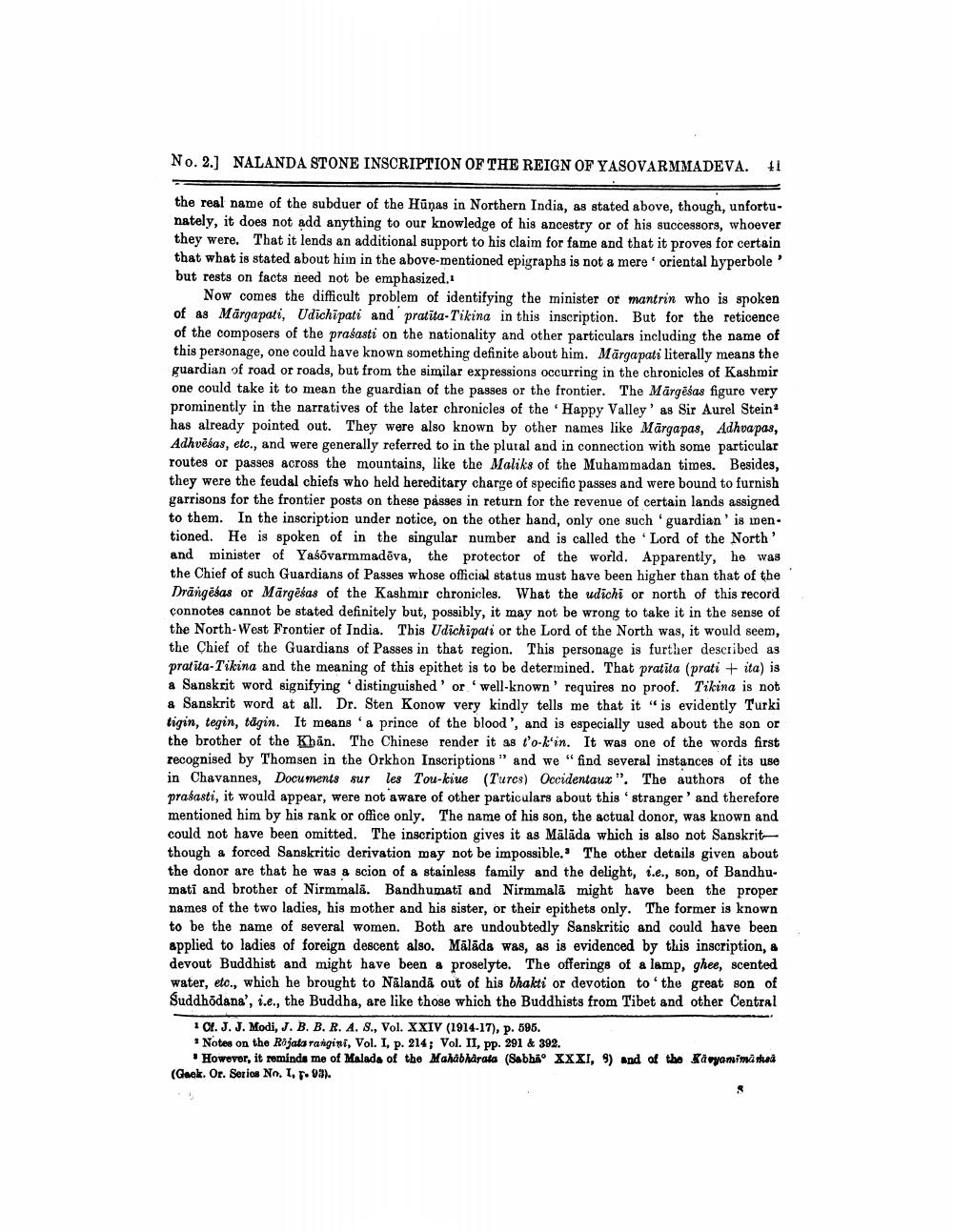________________
No. 2.) NALANDA STONE INSCRIPTION OF THE REIGN OF YASOVARMMADEVA.
1
the real name of the subduer of the Hūņas in Northern India, as stated above, though, unfortunately, it does not add anything to our knowledge of his ancestry or of his successors, whoever they were. That it lends an additional support to his claim for fame and that it proves for certain that what is stated about him in the above-mentioned epigraphs is not a mere' oriental hyperbole but rests on facts need not be emphasized.
Now comes the difficult problem of identifying the minister or mantrin who is spoken of as Märgapati, Udichipati and pratita-Tikina in this inscription. But for the reticence of the composers of the prasasti on the nationality and other particulars including the name of this personage, one could have known something definite about him. Märgapati literally means the guardian of road or roads, but from the similar expressions occurring in the chronicles of Kashmir one could take it to mean the guardian of the passes or the frontier. The Märgēšas figure very prominently in the narratives of the later chronicles of the 'Happy Valley' as Sir Aurel Stein has already pointed out. They were also known by other names like Märgapas, Adhvapas, Adhvēšas, etc., and were generally referred to in the plural and in connection with some particular routes or passes across the mountains, like the Maliks of the Muhammadan times. Besides, they were the feudal chiefs who held hereditary charge of specific passes and were bound to furnish garrisons for the frontier posts on these passes in return for the revenue of certain lands assigned to them. In the inscription under notice, on the other hand, only one such guardian' is men. tioned. He is spoken of in the singular number and is called the Lord of the North' and minister of Yasovarmmadēva, the protector of the world. Apparently, he was the Chief of such Guardians of Passes whose official status must have been higher than that of the Drängesas or Märgėšas of the Kashmir chronicles. What the udichi or north of this record connotes cannot be stated definitely but, possibly, it may not be wrong to take it in the sense of the North-West Frontier of India. This Udichipati or the Lord of the North was, it would seem, the Chief of the Guardians of Passes in that region. This personage is further described as pratita-Tikina and the meaning of this epithet is to be determined. That pratita (prati + ita) is a Sanskrit word signifying distinguished' or 'well-known' requires no proof. Tikina is not & Sanskrit word at all. Dr. Sten Konow very kindly tells me that it is evidently Turki tigin, tegin, tägin. It means a prince of the blood', and is especially used about the son or the brother of the Khān. The Chinese render it as t'o-k'in. It was one of the words first recognised by Thomsen in the Orkhon Inscriptions" and we "find several instances of its use in Chavannes, Documents sur les Tou-kiue (Turcs) Occidentaux". The authors of the prasasti, it would appear, were not aware of other particulars about this stranger' and therefore mentioned him by his rank or office only. The name of his son, the actual donor, was known and could not have been omitted. The inscription gives it as Māläda which is also not Sanskrit though a forced Sanskritic derivation may not be impossible. The other details given about the donor are that he was & scion of a stainless family and the delight, i.e., son, of Bandhumati and brother of Nirmmalā. Bandhumati and Nirmmalā might have been the proper names of the two ladies, his mother and his sister, or their epithets only. The former is known to be the name of several women. Both are undoubtedly Sanskritic and could have been applied to ladies of foreign descent also. Mālāde was, as is evidenced by this inscription, a devout Buddhist and might have been a proselyte. The offerings of a lamp, ghee, scented water, etc., which he brought to Nālandã out of his bhakti or devotion to the great son of Suddhödana', i.e., the Buddha, are like those which the Buddhists from Tibet and other Central
1 Cl. J. J. Modi, J. B. B. R. A. 8., Vol. XXIV (1914-17), p. 595. Notes on the Rajata rangini, Vol. I. p. 214; Vol. II, pp. 291 & 392.
However, it reminds me of Malada of the Mahabharata (Sabbão XXXI, S) and of the Kapyanima sa (Geek. Or. Serios No. 1, 03).




